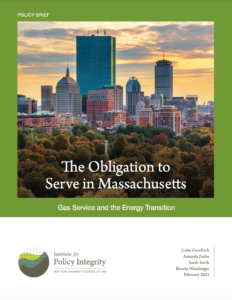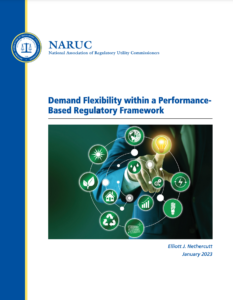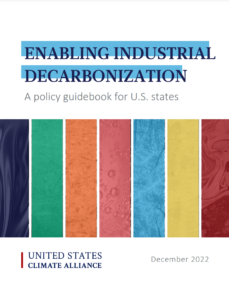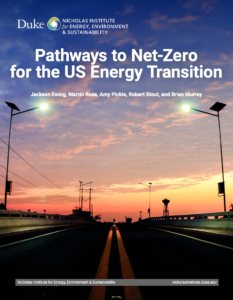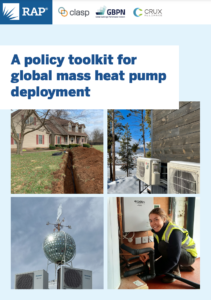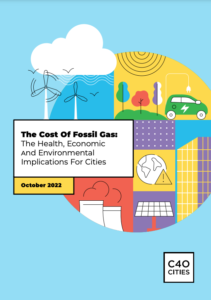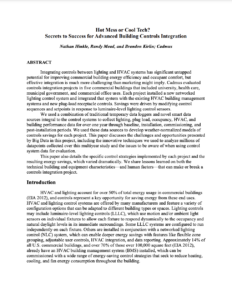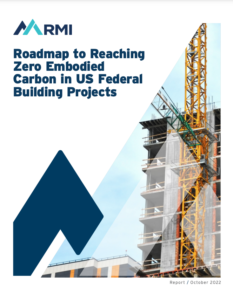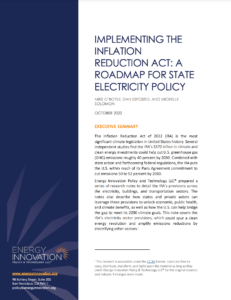The OurEnergyLibrary aggregates and indexes publicly available fact sheets, journal articles, reports, studies, and other publications on U.S. energy topics. It is updated every week to include the most recent energy resources from academia, government, industry, non-profits, think tanks, and trade associations. Suggest a resource by emailing us at info@ourenergypolicy.org.
Resource Library
131 to 140 of 343 item(s) were returned.
Almost 100 municipalities and four states have now adopted policies that require or encourage building electrification. As a result, the entire landscape of building in the U.S. has permanently changed. This movement has transformed numerous sectors and industries and will forever alter how American households perform basic necessities like heating and cooling their living spaces, cooking their meals, or getting hot water. Innovative companies are responding to these market signals. New technologies like cold-climate heat pumps and battery-powered induction stoves are rolling out and solving some of the most challenging aspects of making buildings 100% electric. Because they deliver unmatched …
View Full ResourceIn Massachusetts, achieving the state’s decarbonization target in a cost-effective manner will likely require the refusal of new gas service in addition to the termination of existing gas service in certain buildings and its replacement with electric service. The scope of utilities’ legal obligation to serve their customers will be central to those efforts. Local distribution companies (LDCs) must generally continue service to existing customers in their territories unless the costs of providing service would result in a permanent financial loss (except in certain instances of nonpayment). However, the Massachusetts Department of Public Utilities (DPU) might have some discretion to …
View Full ResourceThe jointly formed National Association of State Energy Officials (NASEO)-National Association of Regulatory Utility Commissioners (NARUC) Grid-Interactive Efficient Buildings (GEBs) Working Group released the report Roadmapping: A Tool for States to Advance Load Flexibility and Grid-Interactive Efficient Buildings in 2021. The 2021 report explored various tools available for states to advance load flexibility and GEBs, aimed at State Energy Offices, Public Utility Commissions (PUCs), and other state and local agencies. This paper builds on past insights with a closer examination of demand flexibility (DF) barriers and implementation within a performance-based regulatory framework. As more complex forms of DF are introduced, …
View Full ResourceWorldwide, policy attention and investment have been uneven across major emitting sectors, with most attention over the past several decades focused on transportation, buildings, and utilities. However, industrial energy and electricity consumption account for 34 percent of global net GHG emissions, the largest emissions source by far. In the United States, this trend also holds true. Although industrial GHG emissions remained flat over the past decade, the sector is projected to become the largest source of national GHG emissions by 2030 absent additional policy intervention.
The U.S. Climate Alliance (“the Alliance”), a coalition of 24 governors committed to achieving the …
View Full ResourceWhat will it take to achieve a net-zero carbon emissions footprint for the US economy by 2050? This report from Energy Pathways USA helps strengthen the evidence base on what will be required for a robust US energy transition and elucidates key barriers and opportunities for reaching net-zero goals.
The authors examine past and present emissions trends and highlight common threads across recent quantitative analyses of potential net-zero trajectories, identifying sectors and shifts that could significantly boost decarbonization. Transforming the electricity grid—with clean energy production, increased high-voltage transmission, and grid modernization for resilience and reliability—is critical to all of these …
View Full ResourceHeat pumps, a critical technology for clean energy systems, are poised to become the most important technology for heating decarbonisation. Currently, the vast majority of heat is provided by fossil fuels. In order to promote and encourage heat pump installations across the globe, the Regulatory Assistance Project, CLASP and the Global Buildings Performance Network have developed this heat pump policy toolkit, which provides a suite of tools, and advice on how to use them, for policymakers interested in promoting this critical technology.
The structure of the toolkit is loosely based on that of a Greek temple, with foundations and pillars, …
View Full ResourceFossil gas, or natural gas, is often touted as a ‘clean’ alternative to coal and a bridge fuel to renewables. It is, however, a key part of the fossil fuel problem. It consists largely of methane, an especially potent greenhouse gas (GHG). When burned for energy, fossil gas produces significant air pollution and carbon dioxide (CO2) emissions as well as harmful social, economic and environmental impacts. It accounts for around a quarter of global energy supply and a fifth of CO2 emissions from energy. Urban energy use is driving up demand.
This research assesses the climate, air quality and health …
View Full ResourceIntegrating controls between lighting and HVAC systems has significant untapped potential for improving commercial building energy efficiency and occupant comfort, but effective integration is much more challenging than marketing might imply. Cadmus evaluated controls integration projects in five commercial buildings that included university, health care, municipal government, and commercial office uses. Each project installed a new networked lighting control system and integrated that system with the existing HVAC building management systems and new plug-load receptacle controls. Savings were driven by modifying control sequences and setpoints in response to luminaire-level lighting control sensors.
The authors used a combination of traditional temporary …
View Full ResourceWithin the walls, floors, and foundations of our buildings is an often-overlooked source of climate pollution commonly referred to as embodied carbon — the millions of tons of carbon emitted during the extraction, manufacturing, transport, construction, and end-of-life disposal of the materials that surround us. Public and private sector stakeholders must act now to establish pathways to decarbonize building and infrastructure design and construction, including reducing emissions from building material supply chains. The US federal government is the largest consumer in the world, spending more than $650 billion on products and services each year. The procurement of materials for its …
View Full ResourceThe Inflation Reduction Act of 2022 (IRA) is the most significant climate legislation in United States history. Several independent studies find the IRA’s $370 billion in climate and clean energy investments could help cut U.S. greenhouse gas (GHG) emissions roughly 40 percent by 2030. Combined with state action and forthcoming federal regulations, the IRA puts the U.S. within reach of its Paris Agreement commitment to cut emissions 50 to 52 percent by 2030.
Energy Innovation Policy and Technology LLC® prepared a series of research notes to detail the IRA’s provisions across the electricity, buildings, and transportation sectors. The notes also …
View Full Resource
